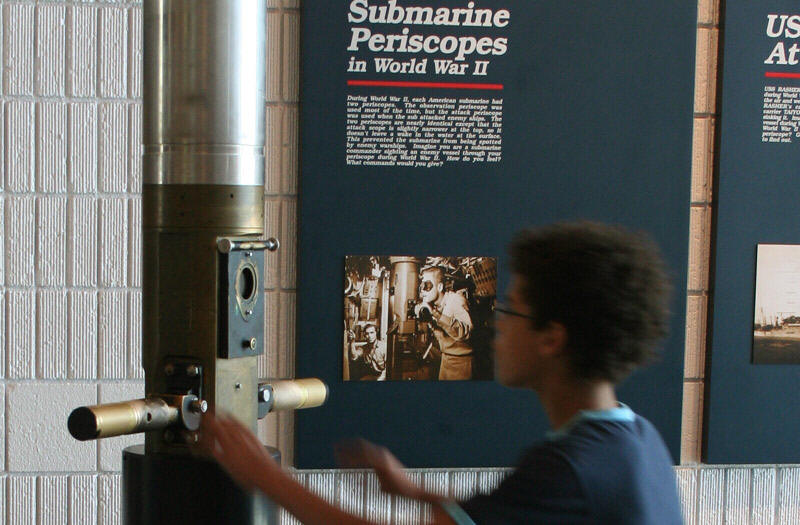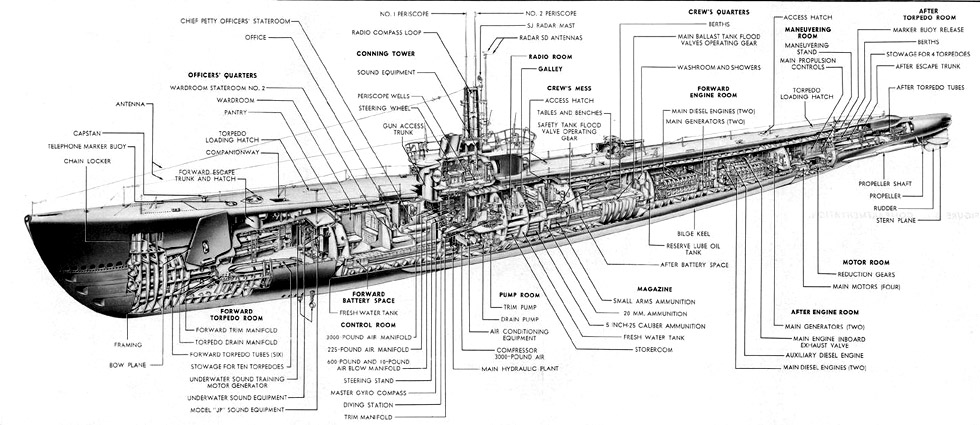The Cobia
The Cobia is a Gato class submarine, one of 77 built. Of this total, 6 remain, all having been converted to museums. The boats (in the Navy, submarines are always called boats - never ships) were first put into service in 1943, and were generally retired in the fifties, though one remained in service until 1969. The Cobia was built in Groton, which is where most of the boats were made. This boat has been in Manitowoc, at the Maritime Museum, since 1969. The area has a long and distinguished ship building tradition. Though the Cobia was not built here, a number of boats of the same class were.
The Cobia is a Gato class submarine, one of 77 built. Of this total, 6 remain, all having been converted to museums. The boats (in the Navy, submarines are always called boats - never ships) were first put into service in 1943, and were generally retired in the fifties, though one remained in service until 1969. The Cobia was built in Groton, which is where most of the boats were made. This boat has been in Manitowoc, at the Maritime Museum, since 1969. The area has a long and distinguished ship building tradition. Though the Cobia was not built here, a number of boats of the same class were.
|
|
A look up the double door escape hatch. Basically, crewmen of a stricken sub would come in here, seal the lower hatch, allow water in through valves, until pressure equalized, and then leave through the upper hatch. A special device would allow the men to exhale while ascending, so that they did not rupture their lungs. |
|
|
We are all gathered in the control room. It is a small space, which was generally manned by seven crew members. Because of the cramped quarters everywhere, men who were not on duty were in their bunks, or in he mess. |
|
|
A look back at the open hatch. During attack, these water tight hatches were all kept closed and locked, making the already small confines of the boat even more constricting. |
|
|
This is the helm, the steering station. In front of the helmsman are indicators of speed, depth, angle, and direction. The large brass wheel controls the ship's rudder. |
|
|
To the left of the helm, and facing the side of the boat, is the station for the planesmen. These wheels control the diving planes, the fins on the front, and conning tower of the boat. These are only usable while submerged, and can act as wings to adjust the angle of the boat. |
|
|
A look down the side of the control room, showing the many valves, and gauges used in the control of the ballast tanks. |
|
|
The galley, where meals, and snacks are prepared for the officers and crew. The cooks were the only members of the crew who are allowed, even encouraged, to shower every day. |
|
|
This is the crew's mess. each table was set to seat six men, so that 24 could be fed at a sitting. Note the magazines, and the large radio receiver in the corner. |
|
|
The temporary "crew" sits in the mess, while our guide explains a few things about the ship. |
|
|
The Red Light District. This is the crew quarters. Bunks are narrow, not particularly comfortable, and have very little headroom. Red lights are kept on in this room at all times. |
|
|
This is the head, showers, and sinks, for the crew. There is little privacy here, and the men are only allowed to shower intermittently, due to limited water stowage on the boat. |
|
|
Aft of the crew quarters is the forward engine room. This room, as well as the adjoining aft engine room are identical. Each holds a pair of diesel engines. These engines do not propel the boat directly; but run generators, which power the electrical propulsion motors. |
|
|
The engine control panel, for the diesel engines that turned the generators. Each 16 cylinder engine produced 5400 HP. The ship had a range, at 10 knots, of 11000 miles, on just under 100,000 gallons of fuel. Though capable of more speed, this was very costly in terms of fuel and range. |
|
|
A look back at the engine room. The two engines made this room so noisy, that all communication was by hand signal. It was also, needless to say, very hot in here. While temperatures throughout a sub were generally in the balmy 90's, they were regularly in the very hot 100 - 120 degree range in the engine compartments. |
|
|
A look aft, towards the entrance to the maneuvering room, and toward the control panel of the aft engine room. The maneuvering room is essentially a narrow hall around a large cage, where the steering gear is located. |
|
|
Aft of maneuvering, is the electrical control room. This is where generators are switched in, and the electric engines, which actually propel the ship, are controlled. The ship can run submerged for 48 hours at two knots. Faster speeds, drain the batteries much more quickly, and greatly reduce range and endurance. |
|
|
The electrical controls. In this room, battery charging, generation, and speed are controlled. These controls determine how many of the diesel engines run the motor, and how many charge the batteries. They also control motor speed. |
|
|
|
|
|
These two photos are of the aft torpedo room. This room only has four tunes, and is great for running away, or for positioning the boat between ships, and hitting from both sides at once. |
|
|
We all take one last look around the deck, before we have to leave, to make room for the next group. |
|
|
A look at the aft facing AA gun, as well as some of the navigational gear, of the lower portion of the conning tower. |
|
|
|
 |
A potential future submariner approaches a working periscope, which looks out onto downtown Manitowoc. |
|
|
|
 |
|